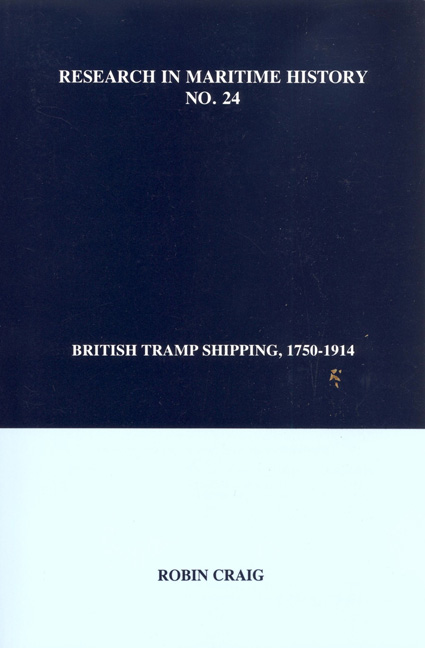Book contents
- Frontmatter
- Contents
- Introduction
- Tramp Shipping and Ownership
- “Aspects of Tramp Shipping and Ownership”
- “Capital Formation in Shipping”
- The Trades
- The Seamen
- Tramp-Shipping Regions
- A. Wales
- B. The Northwest
- C. The West Country
- D. The Northeast
- E. The Southeast
- F. The British Empire: Maritime Canada
- Bibliography
“Capital Formation in Shipping”
from Tramp Shipping and Ownership
- Frontmatter
- Contents
- Introduction
- Tramp Shipping and Ownership
- “Aspects of Tramp Shipping and Ownership”
- “Capital Formation in Shipping”
- The Trades
- The Seamen
- Tramp-Shipping Regions
- A. Wales
- B. The Northwest
- C. The West Country
- D. The Northeast
- E. The Southeast
- F. The British Empire: Maritime Canada
- Bibliography
Summary
There can be little doubt that the capital invested in shipping represented one of the most important forms of fixed (although floating and moveable) capital in Britain in the period of industrialization. There are major problems, however, in making reliable estimates of annual capital formation in shipping before the 1786 Navigation Act, which made sweeping changes in shipping registration procedure. The first part of this discussion examines some of the pitfalls which are encountered in the assessment of pre-1786 shipping statistics, upon which any estimates of capital formation will have to be based, followed by some tentative observations upon the methods by which investment in shipping may be quantified in the new era for the British merchant marine which was ushered in by Charles Jenkinson's great 1786 Act. Modern registry procedure began in that year, and although the system was subsequently modified in certain respects, the quantitative data provided as a consequence of the 1786 Act permit almost continuous measurement of the British merchant marine from 1789 up to the present day. Despite the abundance of the quantitative data, this paper is exploratory in character, but it is intended that estimates of capital formation in the British merchant marine will form part of a history of the shipping industry between 1750 and 1914 which is now being prepared for publication.
There are two basic types of pre-1786 statistical series relating to British shipping. The first provides aggregates, often on a port-by-port basis, of the number and tonnage of vessels which annually entered and cleared British ports. Such returns exist in respect of both the coastwise and foreign trades, but not as a continuous annual sequence until the 1770s. The second type of return indicates the number and tonnage of vessels “accounting each vessel but once“ which annually entered and cleared their home ports in the foreign, coastwise and fishing trades. These latter returns, like the former, are discontinuous, and no long series appears to have survived. The second type of return omits the coasting and fishing fleets of the ports of London, and there are various other anomalies in both sets of statistics, which have tended to erode the confidence of those who have sought to use them for specific studies of the trade and shipping of individual ports.
- Type
- Chapter
- Information
- British Tramp Shipping, 1750–1914 , pp. 41 - 58Publisher: Liverpool University PressPrint publication year: 2003



